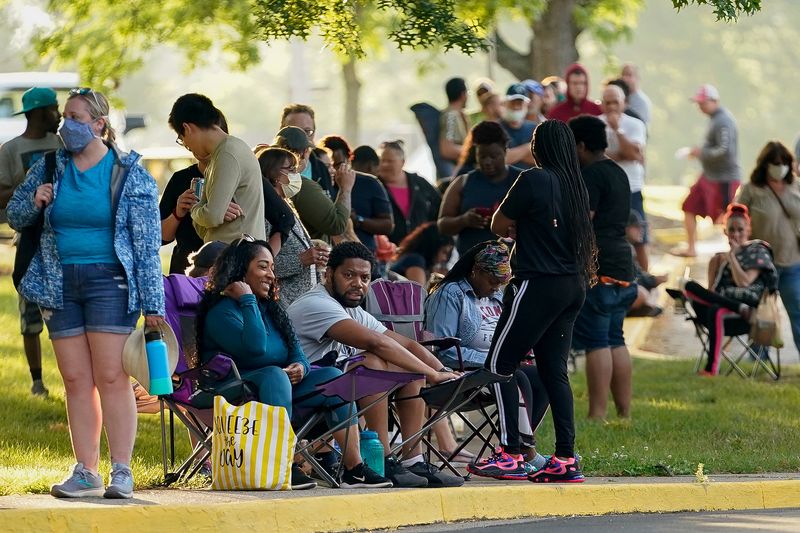[ad_1]

© Reuters. FILE PHOTO: Hundreds of people line up outside the Kentucky Career Center, over two hours prior to its opening, to find assistance with their unemployment claims, in Frankfort, Kentucky, U.S. June 18, 2020. REUTERS/Bryan Woolston/File Photo
By Dan Burns
(Reuters) – The number of people filing for state unemployment benefits for the first time held steady at a 20-month high last week, remaining elevated for a third straight week in what may be an early indication of a softening labor market in the face of the Federal Reserve’s aggressive credit tightening.
The housing market, meanwhile, showed further signs of stabilizing last month after standing out last year as the sector most visibly upended by the Fed’s rate hikes. However, selling prices for existing homes – the largest slice of the U.S. residential property market – tumbled from a year earlier by the most in more than a decade, a demonstration of the choppy nature of the recovery underway.
Data from the Bureau of Labor Statistics on Thursday showed 264,000 new claims were filed for jobless benefits on a seasonally adjusted basis in the week ended June 17, unchanged from the prior week’s upwardly revised level, which is the highest level of initial claims activity since October 2021.
The median expectation among economists polled by Reuters was for 260,000 new claims.
Meanwhile, the ranks of all those continuing to receive benefits beyond the first week fell to 1.759 million in the week ended June 10 from a revised 1.772 million the week before. The latest reading compared with a median economists’ estimate of 1.782 million so-called continued claims.
WHICH IS RIGHT?
New claims have climbed roughly 45% from last September when they hit the lowest since 1969, but even with the upward grind over the ensuing months they remain at levels generally consistent with a healthy job market.
Moreover, the lack of flow through to a persistent move up in continuing claims – which are just 4,000 above the lowest since February – has economists questioning which of the two is the better indicator of the developing state of the labor market.
“The diverging momentum in initial claims and continuing claims raises the obvious question about which data is telling the right story, and how long can this condition persist,” Jefferies U.S. economist Thomas Simons wrote. “We are frankly not sure why.”
Simons saw three possibilities: Laid-off workers are getting rehired quickly; new claims figures continue to be elevated by fraudulent filings that are quickly identified as happened in Massachusetts some weeks ago; or “We are at inflection point in the labor market that will lead to higher continuing claims very soon.”
“The chances of a soft landing in the labor market seem to be increasing somewhat, but there is going to be an ebb and flow on this expectation as we work through this choppy data,” he said.
The question of a soft-landing for the job market and wider economy is the center of attention as the Fed appears to near an end to the rate-hike cycle it began in March 2022 to battle the highest inflation in four decades.
Fed Chair Jerome Powell, in remarks to lawmakers on Wednesday, said the two additional quarter-percentage-point rate hikes by year end reflected in policymakers’ latest projections – from the current level of between 5.00% and 5.25% – was a “good guess” if the economy performs as expected in the months ahead. He did, however, say the Fed – which opted to forego a rate hike at last week’s meeting – is now in a meeting-by-meeting, data-dependent phase of its tightening campaign. Investors broadly expect a hike at the July meeting.
Some other Fed policymakers, though, have begun to signal they would prefer to hold at the current level for longer, an indication the debate over next steps is intensifying as the apparent end point nears. Annual inflation by the Fed’s preferred measure remains well above its 2% target.
HOUSING ON A SLOW MEND
The rate-sensitive residential real estate market, which had taken it on the chin last year as the Fed jacked up rates, showed further signs of steadying last month, but the largest year-over-year selling price drop is among many indications that the sector’s recovery will be uneven in the months ahead.
Existing home sales rose 0.2% to a seasonally adjusted annual rate of 4.3 million units last month, the National Association of Realtors said. Sales rose in the South and West and they fell in the Northeast and Midwest. Economists polled by Reuters had forecast home sales would fall to a rate of 4.25 million units.
Home resales, which account for the largest share of U.S. housing sales, tumbled 20.4% on a year-on-year basis in May.
After topping 7% late last year, mortgage rates have declined somewhat this year and recently have held in a range of between 6.60% and 6.90%. The average contract rate on a 30-year fixed-rate home loan was 6.73% last week, according to the Mortgage Bankers Association.
“Mortgage rates heavily influence the direction of home sales,” said NAR Chief Economist Lawrence Yun. “Relatively steady rates have led to several consecutive months of consistent home sales.”
Limited housing supply is also hindering improvement. The 1.08 million previously owned homes on the market last month – while up slightly from April – was the lowest on record for the month of May.
That could support a recovery in prices, which slid 3.1% from a year earlier to a median $396,100 last month, the fourth decline in a row. That was the largest annual drop since 2011, though economists don’t see that persisting much longer in the face of strong demand for such a limited pool of homes.
[ad_2]
Source link
(This article is generated through the syndicated feed sources, Financetin doesn’t own any part of this article)
